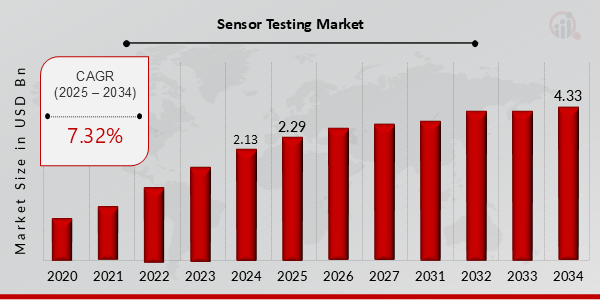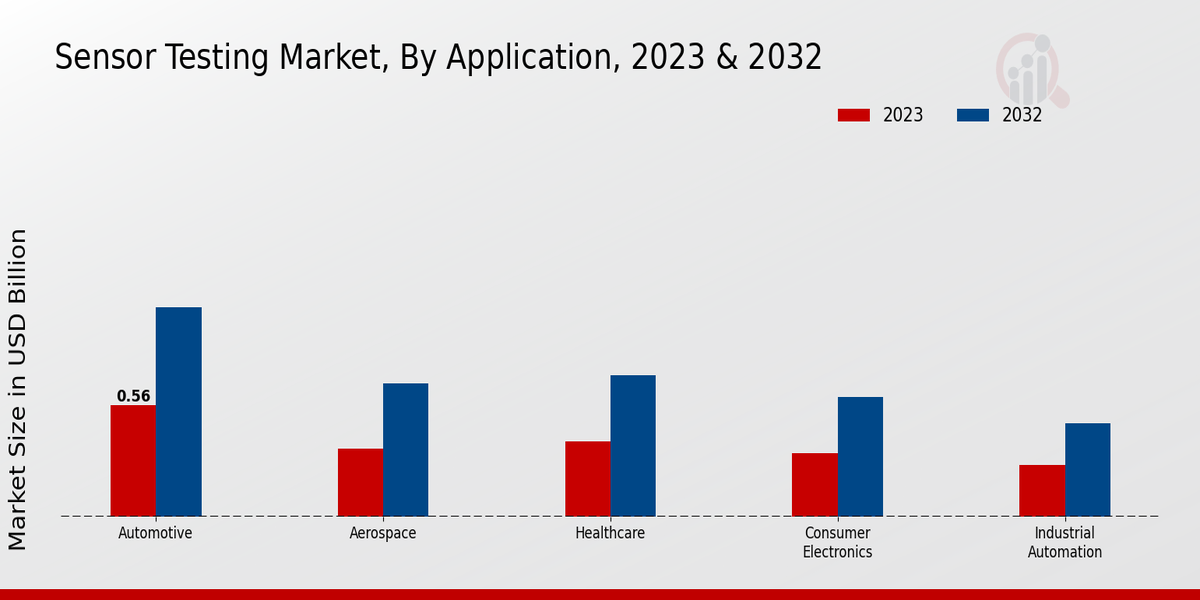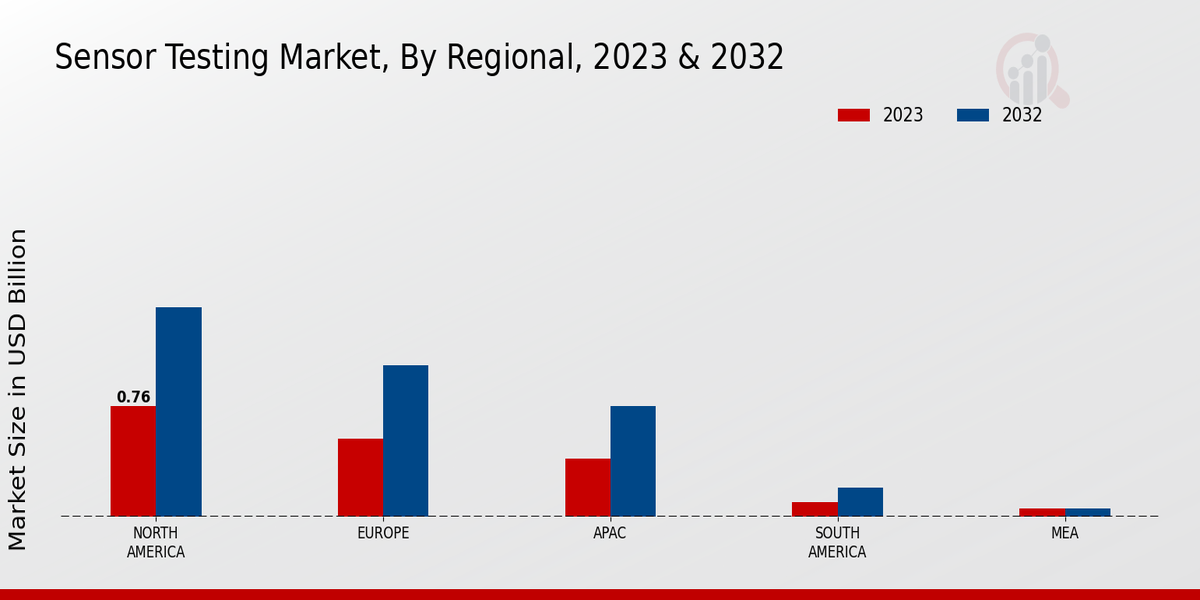Global Sensor Testing Market Overview
Sensor Testing Market Size was estimated at 2.13 (USD Billion) in 2024. The Sensor Testing Market Industry is expected to grow from 2.29 (USD Billion) in 2025 to 4.33 (USD Billion) till 2034, exhibiting a compound annual growth rate (CAGR) of 7.32% during the forecast period (2025 - 2034).
Key Sensor Testing Market Trends Highlighted
The Global Sensor Testing Market is influenced by several key market drivers, such as the growing demand for advanced sensors across various industries. As automation and connectivity become essential in sectors like automotive, healthcare, and consumer electronics, the need for reliable sensor testing is increasing. Innovations in Internet of Things (IoT) technology further fuel this demand, as interconnected devices require precise sensor performance to ensure data accuracy and system reliability.
Additionally, the push for quality assurance and compliance with regulatory standards is driving companies to invest in thorough testing processes, ensuring that sensors function under diverse conditions.Opportunities in the market can be explored through the integration of artificial intelligence and machine learning in sensor testing. These technologies can optimize testing processes by predicting failures and enhancing overall efficiency. Furthermore, with the rise of smart cities and the expansion of renewable energy solutions, there is a growing need for specialized testing services tailored to the specific requirements of these applications.
Companies that can develop flexible and adaptive testing solutions will capture significant market share by meeting the unique demands of various sectors. Recent trends show a shift towards wireless sensor technology, which allows for easier deployment and maintenance.As industries adopt more remote monitoring solutions, the need for robust testing methods for wireless sensors has emerged. Additionally, sustainability is becoming a focal point, leading to the development of sensors that minimize environmental impact. The emphasis on eco-friendly products is reshaping testing protocols, driving manufacturers to implement greener testing methodologies.
As the landscape evolves, the intersection of technology and sustainability will continue to play a crucial role in shaping the Global Sensor Testing Market.

Source: Primary Research, Secondary Research, MRFR Database and Analyst Review
Sensor Testing Market Drivers
Technological Advancements in Sensor Technologies
The Global Sensor Testing Market Industry is witnessing significant growth driven by technological advancements in sensor technologies. The rapid evolution of sensor devices, such as IoT sensors, smart sensors, and wearable technology, has increased the demand for testing services. As the complexity and integration of sensors into various applications grow, so does the need for advanced testing methods to ensure reliability and accuracy.
Innovations in testing methodologies, such as automated testing, simulation, and real-time monitoring, are crucial for meeting the stringent quality and performance standards required in sectors like automotive, healthcare, and aerospace.Furthermore, the advent of 5G technology is enhancing the connectivity and performance of sensors, further propelling the market. The integration of artificial intelligence and machine learning into sensor testing is also emerging as a transformative trend, allowing for predictive maintenance, anomaly detection, and enhancing the overall efficiency of sensor systems.
These advancements not only improve the functionality of sensors but also foster a more competitive market landscape, making testing services indispensable for manufacturers aiming for product excellence.
Increasing Demand for Automation
The Global Sensor Testing Market Industry is also propelled by the increasing demand for automation across various sectors. Industries like manufacturing, automotive, and healthcare are leveraging automation technologies to enhance operational efficiency and reduce human error. This automation trend requires sophisticated sensor systems that must be rigorously tested for accuracy and performance. As companies invest in automation solutions, the need for comprehensive sensor testing becomes paramount to ensure seamless integration and functionality within automated systems.Automated testing processes enable quicker turnaround times and more reliable results, supporting the growing market demand.
Growing Focus on Safety and Compliance
As regulations and standards regarding safety and compliance continue to tighten in numerous industries, the Global Sensor Testing Market Industry experiences an increased focus on ensuring sensors meet these rigorous requirements. From automotive safety systems to medical devices, sensors play a pivotal role in safeguarding lives and enhancing performance. Manufacturers are compelled to invest in thorough testing and validation processes to meet regulatory demands, thereby driving the growth of the sensor testing market.This emphasis on safety ensures that products not only perform effectively but also maintain consumer trust and regulatory compliance.
Sensor Testing Market Segment Insights:
Sensor Testing Market Application Insights
The Global Sensor Testing Market is expected to witness substantial growth across various applications, with a total market value reaching 1.86 USD Billion in 2023. Automotive is the leading application area, representing a significant share with a valuation of 0.56 USD Billion, projected to increase to 1.05 USD Billion by 2032.
This sub-sector is crucial as it involves testing a wide range of sensors essential for safety systems, automated driving technologies, and overall vehicle performance, thus driving demand for advanced sensor testing solutions.In the Aerospace application, the market is valued at 0.34 USD Billion in 2023 and is set to grow to 0.67 USD Billion in 2032. The need for precise and reliable sensor testing in this industry is paramount, especially for navigation and monitoring systems that are critical for flight safety.
The Healthcare segment shows a strong presence with a valuation of 0.38 USD Billion in 2023, projected to increase to 0.71 USD Billion by 2032. The growing emphasis on patient monitoring systems and medical devices underscores its significance, as accurate sensor readings directly impact patient care and outcomes.Consumer Electronics holds a market value of 0.32 USD Billion in 2023, expected to rise to 0.60 USD Billion by 2032. With the proliferation of connected devices and smart technology, this segment is significant for testing sensors in devices such as smartphones and smart home products, reflecting consumer demand for reliability and performance.
Lastly, the Industrial Automation application, although comparatively smaller, with a value of 0.26 USD Billion in 2023 and growing to 0.47 USD Billion by 2032, plays an essential role in optimizing production processes and automation systems, demonstrating the rising trend of smart factories and process automation in the industrial sector.The Global Sensor Testing Market statistics indicate a diverse range of applications, each contributing uniquely to the overall revenue, underscoring the increasing importance of sensor technologies in various industries.

Source: Primary Research, Secondary Research, MRFR Database and Analyst Review
Sensor Testing Market Sensor Type Insights
The Global Sensor Testing Market, expected to reach a value of 1.86 billion USD in 2023, illustrates a robust landscape influenced by various sensor types. The segmentation of temperature sensors, pressure sensors, proximity sensors, chemical sensors, and optical sensors reflects a diverse demand across multiple industries. Temperature sensors are vital in optimizing environmental controls, while pressure sensors play a crucial role in industrial applications and automotive systems.
Proximity sensors are predominantly employed in automation and smart device technologies, driving their significance in the market.Chemical sensors, essential for monitoring air quality and safety levels, have gained traction in response to environmental concerns, thus reinforcing their competitive position. Moreover, optical sensors have become integral in fields like healthcare and automotive, supporting advanced imaging and detection mechanisms. The market growth reflects trends such as increased automation and a growing focus on safety and efficiency in various sectors, fueled by technological advancements and the need for reliable and precise sensor testing.
The overall Global Sensor Testing Market data points to a consistent growth trajectory driven by the diversification and evolving nature of its segments.
Sensor Testing Market Testing Method Insights
The Global Sensor Testing Market, valued at 1.86 billion USD in 2023, reveals significant insights within the Testing Method segment. This segment encompasses various methodologies crucial for assessing sensor performance, including Functional Testing, Environmental Testing, Calibration Testing, Mechanical Testing, and Electrical Testing. Functional Testing is essential for ensuring that sensors perform their intended tasks effectively, while Environmental Testing simulates real-world conditions, verifying durability and reliability. Calibration Testing is critical for maintaining accuracy in sensor measurements, enabling precise data gathering.Mechanical Testing evaluates the structural integrity of sensors under various stress conditions, and Electrical Testing examines the stability of electronic components.
The combined efforts of these methodologies not only facilitate compliance with industry standards but also drive innovation and efficiency in sensor technology. As the market continues to evolve, these Testing Methods are vital for addressing emerging challenges, ensuring product quality, and capitalizing on opportunities arising from the increasing deployment of sensor technologies across various sectors, thus contributing to the anticipated market growth.The Global Sensor Testing Market industry is on a growth trajectory, with robust Global Sensor Testing Market revenue projections for the coming years, underscoring the importance of these testing methodologies in shaping market trends.
Sensor Testing Market End Use Insights
The Global Sensor Testing Market has shown substantial growth, with a market value of 1.86 USD Billion in 2023 and a projected increase to 3.5 USD Billion by 2032. Within the market, the different end users, such as manufacturers, service providers, and research institutions, play vital roles. Manufacturers often dominate the Global Sensor Testing Market due to their need for reliable sensor performance to ensure product safety and efficiency.
Service providers contribute by offering specialized testing solutions, enabling manufacturers to maintain quality standards and regulatory compliance.Research institutions, on the other hand, significantly drive innovation by developing new sensor technologies and testing methodologies, which ultimately enhances the overall market growth. The key trends in the industry indicate a steady rise in demand for advanced sensor technologies, propelled by emerging applications in IoT, automotive, and healthcare sectors.
However, challenges such as the need for standardization and high costs associated with sensor testing persist, representing both a hurdle and an opportunity for growth in the industry.Overall, the combination of these end users underlines the importance of collaboration and innovation, ensuring the forward momentum of the Global Sensor Testing Market.
Sensor Testing Market Regional Insights
The Global Sensor Testing Market is poised for significant growth across various regions, with the market expected to reach a valuation of 1.86 USD Billion in 2023. North America holds a majority share, valued at 0.76 USD Billion, and is anticipated to grow to 1.44 USD Billion by 2032, driven by advancements in sensor technologies and a strong demand from automotive and healthcare industries.
Europe follows closely, valued at 0.54 USD Billion in 2023 and expected to increase to 1.04 USD Billion, supported by stringent regulations and growing investments in smart technologies.The APAC region, while currently valued at 0.4 USD Billion, is expected to see substantial growth to 0.76 USD Billion, fueled by rapid industrialization and technological adoption. In South America, the market is valued at 0.1 USD Billion, with a moderate growth trajectory expected to reach 0.2 USD Billion, reflecting emerging trends in consumer electronics.
Lastly, the MEA region shows relatively lower activity, maintaining a valuation of 0.06 USD Billion, indicating potential challenges in market penetration. The overall Global Sensor Testing Market revenue reflects robust demand across regions, highlighting varied growth drivers and market dynamics.

Source: Primary Research, Secondary Research, MRFR Database and Analyst Review
Sensor Testing Market Key Players and Competitive Insights:
The Global Sensor Testing Market is experiencing significant growth due to the increasing reliance on sensor technology in various industries such as automotive, healthcare, industrial automation, and consumer electronics. This market encompasses a wide range of players offering both hardware and software solutions designed to ensure the functionality and reliability of sensors. Competition is intensifying as advanced technologies like the Internet of Things, and artificial intelligence dictate the level of sophistication needed in sensor testing methodologies.
Companies are not only competing on the basis of innovative solutions but also on the ability to provide comprehensive testing services that incorporate quality assurance, operational efficiency, and compliance with international standards. As the demand for high-performance sensors rises, companies are striving to enhance their testing capabilities through strategic partnerships, research and development initiatives, and expansions into emerging markets.DigiKey Electronics is a key player in the Global Sensor Testing Market, recognized for its extensive product catalog and distribution capabilities.
The company boasts a robust online presence that allows it to reach a global customer base, enhancing accessibility for businesses seeking sensor testing solutions. DigiKey stands out for its commitment to quality, offering a wide range of electronic components that cater specifically to sensor technology. The company prides itself on its customer service, providing technical support and consultation that positions it as a trusted advisor in sensor testing. With a vast network of suppliers and manufacturers, DigiKey Electronics ensures that its clients have access to the latest technological advancements and testing methodologies.
This strategic positioning and commitment to quality make DigiKey a formidable competitor in the sensor testing landscape.National Instruments plays a pivotal role in the Global Sensor Testing Market, known for its cutting-edge testing and measurement solutions. The company specializes in providing software and hardware designed for testing various types of sensors, emphasizing flexibility and scalability in its offerings. National Instruments has developed a reputation for innovation, enabling users to create tailored testing environments that meet specific sensor requirements. The company’s comprehensive software tools facilitate advanced data acquisition and analysis, allowing engineers to gain deeper insights into sensor performance.
Furthermore, the integration of National Instruments' solutions with industry standards has solidified its presence in the market, as clients can confidently rely on their capabilities for critical testing applications. Their strategic focus on research and development continually enhances their portfolio, helping to address the evolving needs of the sensor testing sector.
Key Companies in the Sensor Testing Market Include:
Sensor Testing Market Industry Developments
Recent developments in the Global Sensor Testing Market indicate significant advancements in technology and market activities. Companies like DigiKey Electronics and National Instruments are focusing on enhancing their sensor testing capabilities to cater to the growing demand in sectors such as automotive, industrial automation, and IoT. Underpinning this growth, the market valuation for firms like Texas Instruments and STMicroelectronics has witnessed an upswing, driven by increased investments in R&D and emerging applications in smart devices.
Mergers and acquisitions among key players are shaping the competitive landscape; for example, Honeywell has been involved in strategic partnerships to bolster its sensor technology portfolio, while Bosch Sensortec is actively seeking collaborations to expand its market reach. Additionally, Keysight Technologies and Teledyne Technologies are making strides in innovation, contributing to the overall growth of the sector. The ongoing developments demonstrate a vibrant market environment marked by technological progress and strategic realignments, fostering opportunities for players like Analog Devices, Siemens, and Omron to enhance their offerings and competitive positioning.
The synergy from these advancements is likely to further amplify the sensor testing market's potential as industries seek more robust and efficient solutions.
Sensor Testing Market Segmentation Insights
Sensor Testing Market Application Outlook
Sensor Testing Market Sensor Type Outlook
Sensor Testing Market Testing Method Outlook
Sensor Testing Market End Use Outlook
Sensor Testing Market Regional Outlook
|
Report Attribute/Metric
|
Details
|
|
Market Size 2024
|
USD 2.13 Billion
|
|
Market Size 2025
|
USD 2.29 Billion
|
|
Market Size 2034
|
USD 4.33 Billion
|
|
Compound Annual Growth Rate (CAGR)
|
7.32% (2025-2034)
|
|
Base Year
|
2024
|
|
Market Forecast Period
|
2025-2034
|
|
Historical Data
|
2020-2023
|
| Market Forecast Units |
USD Billion |
| Key Companies Profiled |
DigiKey Electronics, National Instruments, Tektronix, STMicroelectronics, Texas Instruments, Honeywell, Rohde and Schwarz, Bosch Sensortec, Infineon Technologies, Keysight Technologies, Murata Manufacturing, Analog Devices, Teledyne Technologies, Siemens, Omron |
| Segments Covered |
Application, Sensor Type, Testing Method, End Use, Regional |
| Key Market Opportunities |
Autonomous vehicle development surge, Increasing IoT applications, Rising demand for environmental monitoring, Advancements in sensor technology, Growing focus on quality assurance. |
| Key Market Dynamics |
Technological advancements in sensors, Growing IoT applications, Increasing demand for automation, Strict regulatory standards, Rising adoption of smart devices |
| Countries Covered |
North America, Europe, APAC, South America, MEA |
Frequently Asked Questions (FAQ):
The Global Sensor Testing Market is expected to reach a value of 4.33 USD Billion by 2034.
The expected CAGR for the Global Sensor Testing Market from 2025 to 2034 is 7.32%.
North America is projected to have the largest market size, valued at 1.44 USD Billion by 2032.
The Automotive application segment is expected to be valued at 1.05 USD Billion by 2032.
Key players include DigiKey Electronics, National Instruments, and Honeywell among others.
The Aerospace application segment is anticipated to reach a value of 0.67 USD Billion by 2032.
The Healthcare application segment is expected to be valued at 0.71 USD Billion by 2032.
The APAC region's market size is forecasted to reach 0.76 USD Billion by 2032.
The Consumer Electronics segment is expected to be valued at 0.6 USD Billion by 2032.
The Industrial Automation application segment is expected to reach a value of 0.47 USD Billion by 2032.

















